Strategy 3: Reduce emissions at the source
The day-to-day activities of residents and businesses require energy. Today, most of the energy in Washoe County is created by burning fossil fuels, which is the leading source of GHG emissions. By burning fewer fossil fuels, we reduce emissions. To reach Washoe County’s target of net zero GHG emissions by 2050, we must begin reducing fossil fuel emissions in all sectors.
The data below shows sources of 6.32 million metric tons (MMT) of emissions in 2021 across all of Washoe County, including unincorporated Washoe County, Reno, and Sparks.
• Energy use in Buildings is the top source of GHG emissions in Washoe County, causing 56% of total emissions. ~22% of Buildings emissions come from Commercial Buildings while ~19% come from Residential Buildings and 15% come from Industrial Buildings.
• Transportation is the next largest source of emissions, causing 37% of emissions.
• Emissions from Solid Waste—that is, emissions caused by landfill off-gassing—causes 2% of Washoe County’s community emissions.
• Emissions from Process & Fugitive Emissions—physical or chemical processes, not fuel combustion—cause 3% of total emissions
• The energy used to produce Potable Water and to process Wastewater causes 2% of emissions in Washoe County.
• Emissions caused by Agriculture, Forestry, and Other Land Use is very small (<1%).
Carbon Dioxide Equivalents (CO2e) by sector in Million Metric Tons (MMT)
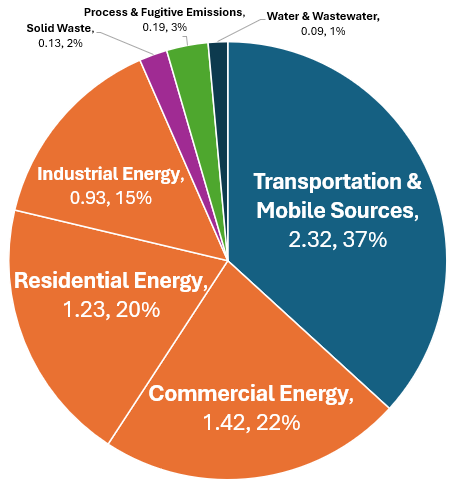
Strategy 3a: Reduce transportation emissions
In the transportation sector, we focus on two goals. The first goal is reduce vehicles on the road and total vehicle miles traveled (VMT). Fewer VMT reduce fuel use, reduce congestion, and reduce wear-and-tear on our roads. The second goal is to shift from internal combustion engine (ICE) vehicles to cleaner vehicles such as zero emissions vehicles (ZEVs), or bicycles, for example. Active modes like walking, biking and riding scooters also reduce emissions, improve public health, and reduce the amount of road space needed for people to move around the region.
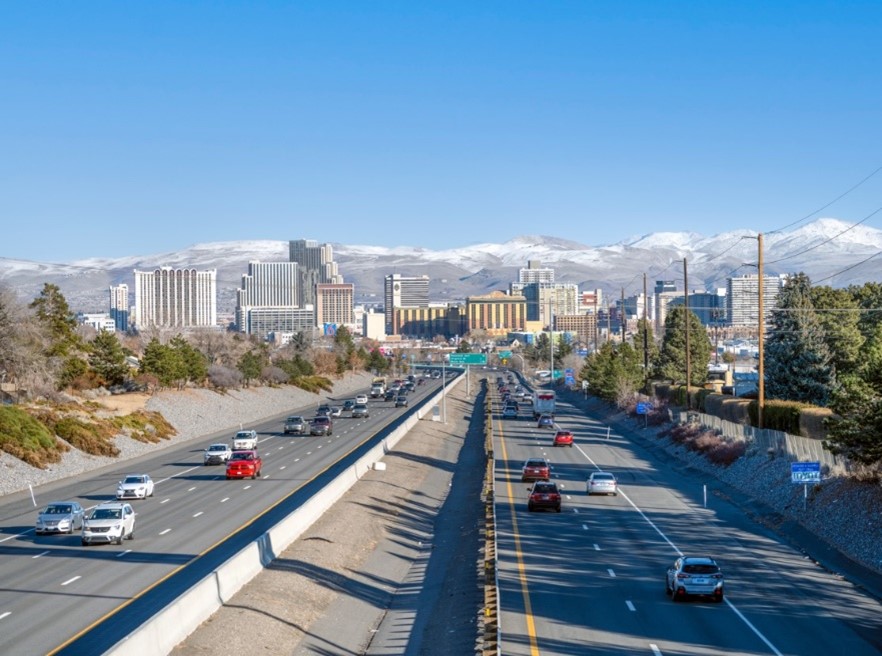
Tier 1 Actions
Reduce Single Occupancy Vehicle (SOV) trips
21. Create an online hub to amplify information about alternatives to single occupancy vehicles (SOVs) for recurring trips. (eg Safe Routes to School, carpooling, existing transit or bicycle infrastructure)22. Create and distribute sustainable transportation guides for Washoe County’s 12 libraries, 49 parks, ~50 voting locations, and 14 buildings with walk-in services.
23. Pursue Trip Reduction Ordinance for Washoe County, including regulations or other measures that reduce congestion.
24. Align regional efforts to reduce SOV trips to the region's top employment areas (eg Tahoe-Reno Industrial Center (TRIC), Reno / Sparks casinos, Lake Tahoe recreation)
25. Expand reliable broadband across Washoe County to enable more telecommuting.
26. Work with transportation and tourism partners to educate visitors about car-free ways to enjoy Reno, Sparks, Lake Tahoe, and other points of interest in and around Washoe County.
Expand adoption of Zero Emissions Vehicles (ZEVs)
27. Support and accelerate RTC Washoe's Walk and Roll plan by supporting grant funding, collecting data to accelerate the 12 neighborhood plans being designed by 2030.28. By 2026, create a regional plan for an equitable network of EV chargers; by 2028, create a plan to fund the EV charging network.
29. Create, support, and/or accelerate a plan to make Washoe County's I-80 corridor the nationwide leader in alternative fuel charging.
Tier 2 Actions
55. Provide rebates for e-bikes, e-cargo bikes, e-motorcycles, e-scooters to individuals and businesses. Provide incentives particularly for LIDACs and businesses operating in low-income areas to replace old polluting vehicles with these technologies.56. Support the federal proposal to extend the Capitol Corridor rail line to include Reno.
57. High speed rail between Reno and Las Vegas to reduce the ~5,000 flights per year between the cities.
58. Support expanded ZEV car-sharing.
59. Support expanded ZEV ride-sharing.
60. Support low carbon sustainable aviation, marine, heavy duty truck, rail fuel development.
Strategy 3b: Reduce commercial and industrial building emissions
The least expensive energy is energy that is never used. Increasing a building’s energy efficiency saves businesses both energy and money. Existing buildings can save energy by utilizing best practices, technical assistance and financing. New buildings can benefit from energy-saving codes and permitting.
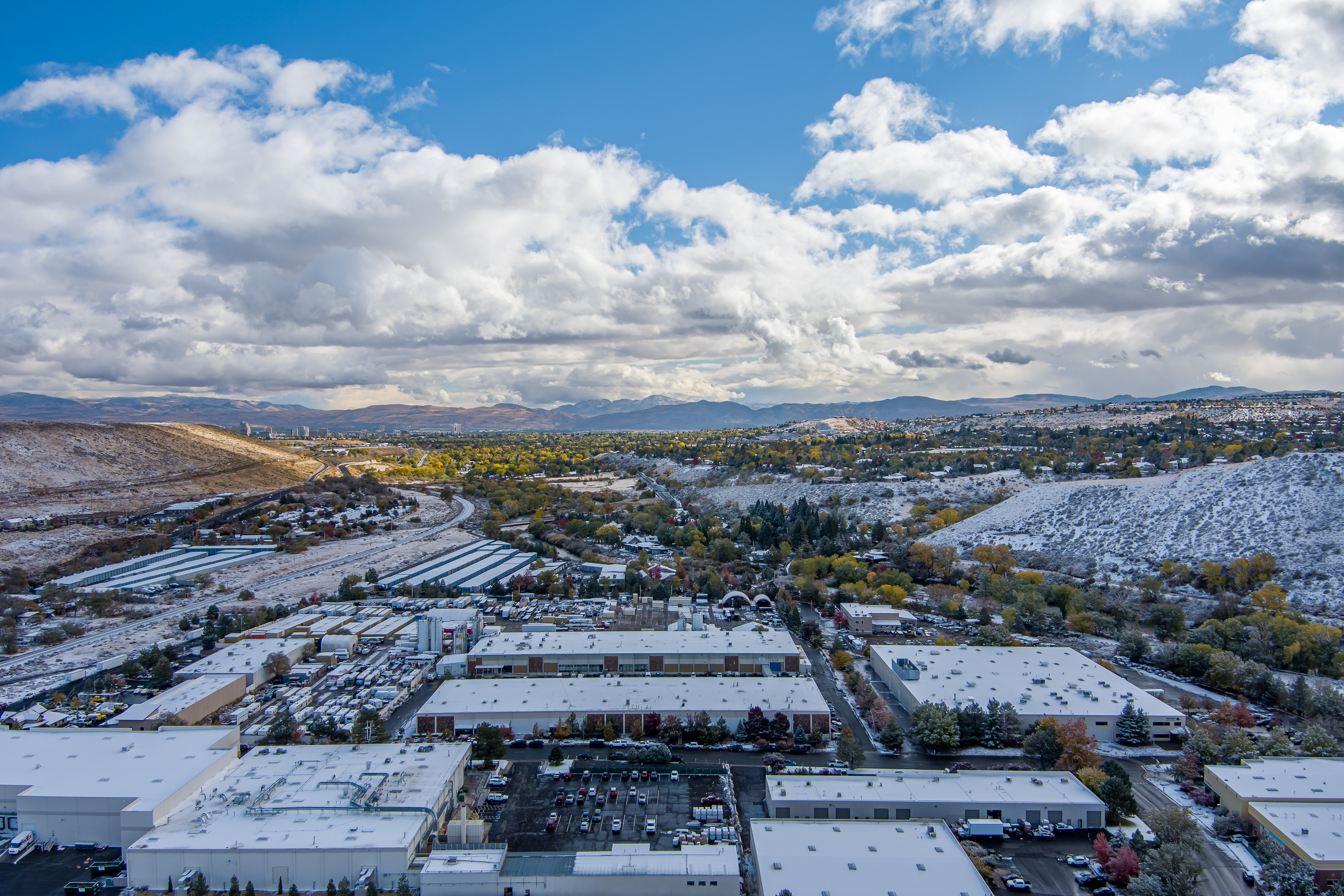
Tier 1 Actions
30. Establish an opt-in Building Performance Standard (BPS) for commercial buildings to identify energy efficiency opportunities and support.31. Adopt "ambitious" (instead of "standard") 2027 and 2030 International Energy Conservation Codes (IECC).
32. Integrate sustainability into government procedures by providing resources during planning and permitting processes (eg provide information about heat pumps to requestors of permits to install new chillers / heaters / boiler).
Tier 2 Actions
61. Transition from gas- to electric-powered lawn equipment.62. Expand and track the number of LEED-certified (or equivalent) buildings in Washoe County. Share case studies to increase awareness and adoption widely with the public and developers.
Strategy 3c: Reduce residential building emissions
Just like commercial buildings, the least expensive energy is energy that is never used. Washoe County wants to empower all home owners and renters to pursue sustainable upgrades for their homes, with emphasis on saving people money by reducing energy bills. Many State of Nevada and federal rebates, incentives, and programs exist right now for energy efficiency audits and upgrades, and many financing opportunities are available for energy efficiency projects (e.g. electrifying appliances, weatherizing homes). Expanding access to these resources will reduce emissions.
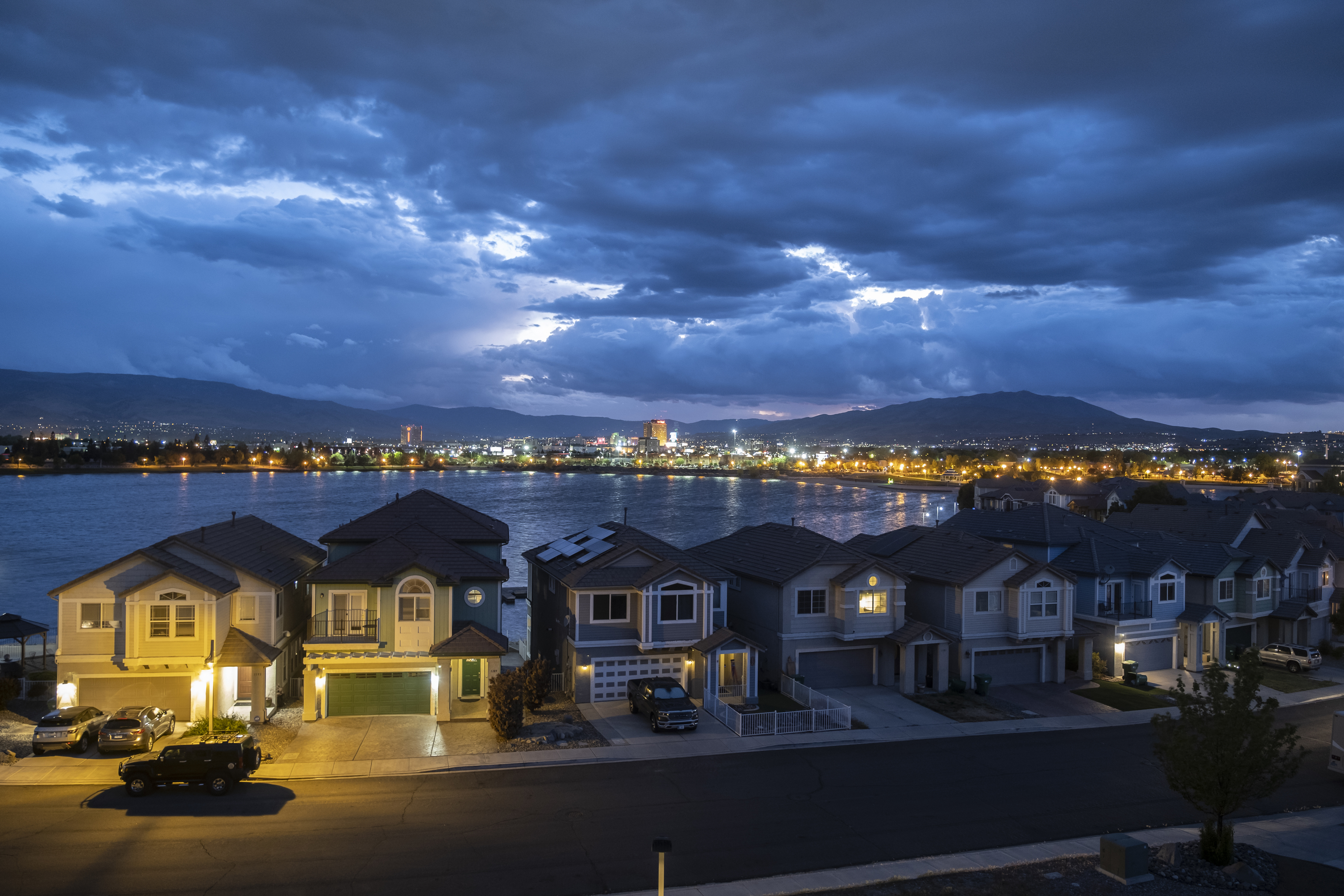
Tier 1 Actions
33. Create virtual and / or physical resource hubs for homeowners and renters to learn how to make sustainable upgrades.34. Amplify awareness of existing home energy efficiency programs such as NV Energy's free energy efficiency audit; Nevada Clean Energy Fund's Residential Energy Upgrade Program (RE-UP); Nevada Housing Division’s Weatherization Assistance Program (WAP); and the federal Home Electrification and Appliance Rebates (HEAR) program.
35. Create a program to convert mobile home power from gas to electric.
36. By 2030, implement at least one sustainable retrofit incentive for rental properties serving income-qualified tenants.
37. By 2026, create toolkit, identify incentives, and identify lending facilities for owners of multi-family, affordable housing, and senior living facilities to make their buildings more energy-efficient.
Tier 2 Actions
63. Provide one free induction burner with a compatible skillet and pot to each household in Washoe County on an opt-in basis.64. Further subsidize heat pump purchases beyond Federal incentives to achieve cost-parity with gas heat / air units
65. Support alternative financing mechanisms to support lower emission buildings, such as community land trusts, on-bill financing, and an emissions-reducing Revolving Loan Fund.
66. Review and upgrade HOA policies that do not align with sustainability goals, e.g. installation of heat pump, installation of solar panels, ability to line-dry clothes.
Strategy 3d: Reduce Waste
Solid waste (trash, recycling, food waste, and green waste) accounts for only 10% of total emissions in Washoe County. However, waste is a daily, tangible reminder about sustainability, and many community members are passionate about the topic. Washoe County will pursue Actions for two services that are often delivered through local government: compost and yard waste. Simultaneously, Washoe County will provide administrative support to community members who are pursuing “Reduce, Reuse, Refuse, Recycle, Repair” principles in various local waste streams. The purpose of these waste reduction efforts is to minimize the content that goes to landfill, because landfills produce GHGs that add to the County’s emissions total.
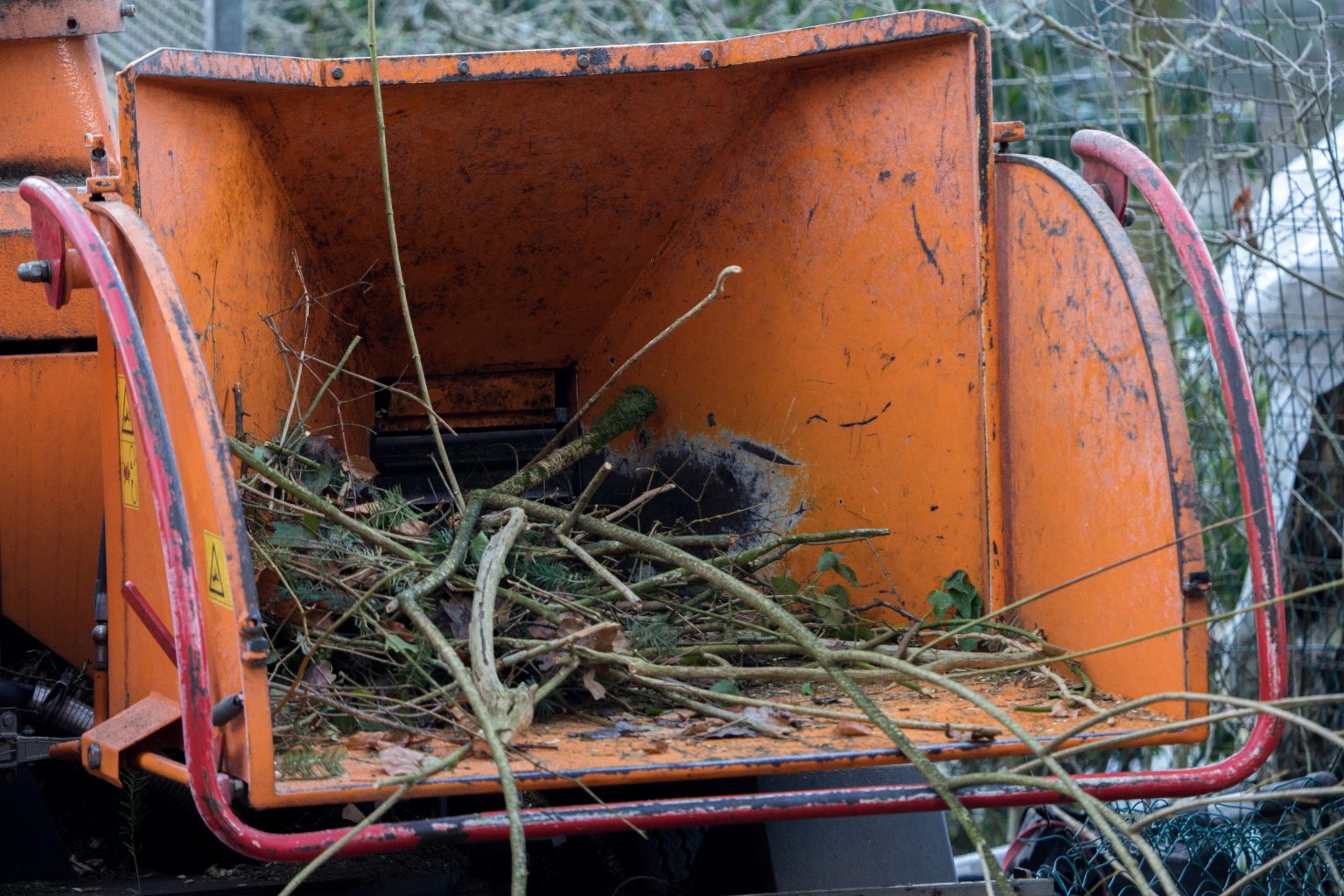
Tier 1 Actions
38. Identify and support food-waste composting pilot projects and providers for both residential and commercial needs.39. Identify and support green-waste composting models and providers for both residential and commercial needs.
40. Provide administrative support to community waste-reduction working groups.
Tier 2 Actions
67. Offer "seed capital," other incentives, or support to local Washoe County or Northern Nevada entrepreneurs / organizations who start and operate businesses designed to address local gaps in waste management (e.g. glass recycling, upcycling services, composting, reusable / refillable and other models or businesses that divert waste from landfills or accelerate a circular economy).
68. Support policies that decrease the prevalence of single-use plastics
69. Support commercial use of compostable materials through establishing a list of approved vendors that have been verified by the Biodegradable Products Institute (BPI) as compostable
70. Increase rate of recycling in multi-family housing and mobile homes from the 2024 rate of 54%.
71. Increase rate of recycling rate at commercial locations from the 2024 rate of 9.5%.
72. Create a sustainable building materials management toolkit for businesses to reduce waste from construction, renovation, demolition, and retrofit projects. Outreach for the toolkit can include, but is not limited to, online resources, a builder’s lunch-and-learn and local business network presentations.
